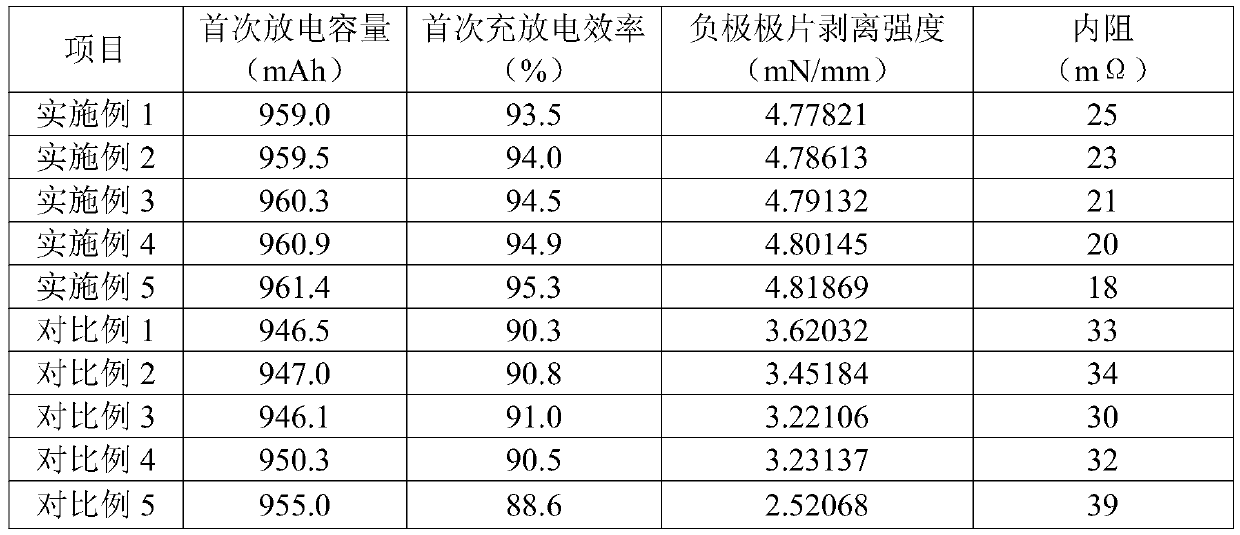Battery electrode binder
A battery electrode and binder technology, applied in battery electrodes, secondary batteries, circuits, etc., can solve the problems of high toxicity of organic solvents, poor adhesion and elasticity, battery capacity decay, etc., and achieve chemical and thermal stability Good, high adhesion and elasticity, long cycle life effect
- Summary
- Abstract
- Description
- Claims
- Application Information
AI Technical Summary
Problems solved by technology
Method used
Image
Examples
Embodiment 1
[0026] A battery electrode binder, which includes a first polymer and a second polymer, the first polymer is first passed through bis(vinylsulfone)propanol and 4,4'-bis-sec-butylaminodiphenyl Methane is polymerized by Michael addition reaction, and then grafted by chloromethyl methyl carbonate; the second polymer is composed of 2,3,4-trifluorocinnamic acid, allyl succinimide Addition polymer of carbonate, (Z)-3-(6-fluoro-1H-indol-3-yl)acrylonitrile, 2-allyloxyphenoxymethyloxirane by copolymerization ; The mass ratio of the first polymer to the second polymer is 1:2.
[0027] The preparation method of the first polymer comprises the steps of:
[0028] Step S1: Add 10 g of bis(vinylsulfone)propanol and 12.9 g of 4,4'-bis-sec-butylaminodiphenylmethane into 80 g of tetrahydrofuran, stir and react at 45°C for 8 hours under nitrogen atmosphere, and then After suspension evaporation and concentration with a rotary evaporator, precipitate with acetone, wash 3 times, and finally dry ...
Embodiment 2
[0032]A battery electrode binder, which includes a first polymer and a second polymer, the first polymer is first passed through bis(vinylsulfone)propanol and 4,4'-bis-sec-butylaminodiphenyl Methane is polymerized by Michael addition reaction, and then grafted by chloromethyl methyl carbonate; the second polymer is composed of 2,3,4-trifluorocinnamic acid, allyl succinimide Addition polymer of carbonate, (Z)-3-(6-fluoro-1H-indol-3-yl)acrylonitrile, 2-allyloxyphenoxymethyloxirane by copolymerization ; The mass ratio of the first polymer to the second polymer is 1:2.3.
[0033] The preparation method of the first polymer comprises the steps of:
[0034] Step S1: Add 10 g of bis(vinylsulfone)propanol and 12.9 g of 4,4'-bis-sec-butylaminodiphenylmethane into 90 g of N,N-dimethylformamide, and in a helium atmosphere, Stir and react at 50°C for 8.5 hours, then concentrate by suspension evaporation with a rotary evaporator, precipitate with acetone, wash 4 times, and finally dry in...
Embodiment 3
[0038] A battery electrode binder, which includes a first polymer and a second polymer, the first polymer is first passed through bis(vinylsulfone)propanol and 4,4'-bis-sec-butylaminodiphenyl Methane is polymerized by Michael addition reaction, and then grafted by chloromethyl methyl carbonate; the second polymer is composed of 2,3,4-trifluorocinnamic acid, allyl succinimide Addition polymer of carbonate, (Z)-3-(6-fluoro-1H-indol-3-yl)acrylonitrile, 2-allyloxyphenoxymethyloxirane by copolymerization ; The mass ratio of the first polymer to the second polymer is 1:2.5.
[0039] The preparation method of the first polymer comprises the steps of:
[0040] Step S1: Add 10 g of bis(vinylsulfone)propanol and 12.9 g of 4,4'-bis-sec-butylaminodiphenylmethane into 100 g of chloroform, and stir the reaction at 53° C. for 9 hours under a neon atmosphere. After that, it was concentrated by suspension evaporation with a rotary evaporator, precipitated with acetone, washed 4 times, and fi...
PUM
 Login to View More
Login to View More Abstract
Description
Claims
Application Information
 Login to View More
Login to View More - R&D Engineer
- R&D Manager
- IP Professional
- Industry Leading Data Capabilities
- Powerful AI technology
- Patent DNA Extraction
Browse by: Latest US Patents, China's latest patents, Technical Efficacy Thesaurus, Application Domain, Technology Topic, Popular Technical Reports.
© 2024 PatSnap. All rights reserved.Legal|Privacy policy|Modern Slavery Act Transparency Statement|Sitemap|About US| Contact US: help@patsnap.com








